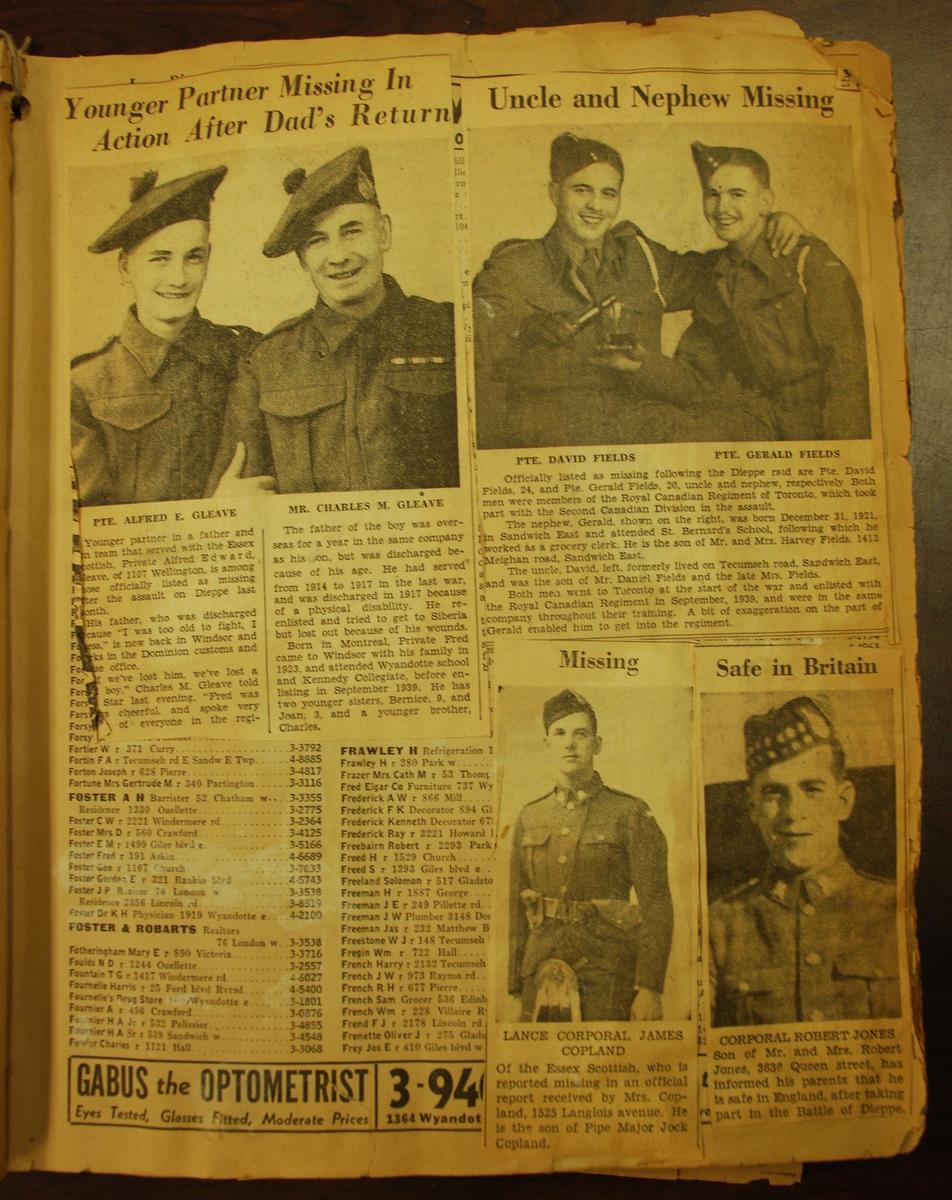Bell Telephone Book of Windsor Casualties

One page of Dieppe casualties pasted into a Bell telephone book, unknown date 1942.
Created during the early years of the Second World War, an unknown person cut newspaper clippings from the Windsor Daily Star and glued them on the pages of a Bell Telephone book for the Windsor and area. The clippings begin with local casualties from bombing missions over Germany and intensified with the casualties from the Dieppe Raid on 19 August 1942. The book has become a valuable record of regiment casualties and visually demonstrates both the devastation of a single military defeat and the enduring willingness of the home front to preserve the memories of those who sacrificed their safety and their lives for the freedom of others.
The Dieppe Raid on 19 August 1942 was a combined operation involving the Navy, Air Force, Commandos, and most of 2nd Canadian Division, of which the Essex Scottish Regiment was part. The raid was particularly devastating for the Windsor-Detroit region since only 51 members of the Regiment of 553 who landed on the beach returned to England that day. The Scottish were tasked as part of the main assault at Red Beach, the eastern half of the main beach near the harbour. The Germans had been informed of the Canadian passage across the English Channel and were able to prepare for their arrival before they landed on the beach at 5:25 a.m. The element of surprise, which the operation had depended on, was gone. This meant that the Essex Scottish were vulnerable to direct German fire from the cliff top and the town to all positions on the beach. They took cover against the seawall, but this did not stop casualties from German machine guns, mortars and artillery.
The Essex Scottish showed incredible bravery in pursuit of their mission. For example, Private Tom McDermott threw himself across coils of barbed wire so other men could use his back to step over the obstacle. The Canadian forces suffered 3367 casualties at the raid out of the 4963 men sent to France. In the Essex Scottish alone, 121 were killed and approximately 382 men were taken prisoner. Of the 54 (including attached out) men that returned to England, twenty-five were injured and two later died in hospital. Only two small groups of the Scottish, led by Company Sergeant Major Cornelius Stapleton and Lieutenant Bill Scott were able to cross the Promenade and reach the town of Dieppe. The Essex Scottish’s engagement at Dieppe was effectively over by 6:30a.m., but the damage inflicted by the assault was severe.
The Bell Telephone Book, composed of 148 pages of newspaper clippings, records the casualties amassed by the Essex Scottish during the Dieppe Raid and other local men overseas during 1942. It is a treasure trove of archival information. Included are those who were injured, taken as prisoners of war, or killed. Pasted together by an unknown donor, the obituaries and casualty lists make up the entirety of the telephone book’s length. Each page is covered by photos and logs of dozens of soldiers present at the battle overseas. The official record of those who served at Dieppe with the Essex Scottish lists approximately 570 names in total, though some men were attached to other regiments. The telephone book mentions most of these men. Other than radio broadcasts, newspapers were the only form of information for family members to track the whereabouts of men who were either reported as prisoners of war or missing. These fragments of communication from war correspondents would often accompany letters and telegrams from the regiments themselves telling families on the home front the outcome of battles for their loved ones. It was often weeks before prisoners of war could send their own correspondence from the POW camps, so the newspapers were a reliable source of information from overseas. However, it was both a source of hope and dread for those across the ocean. As some of these POWs were held for the duration of the war, any news of their condition and whereabouts would have been a comfort for those waiting back home for their return. Conversely, the delay in the publication of newspapers meant that information could become quickly outdated, suggesting that the information received could be incorrect by the time it was released to the public.
The scrapbook is fragile due to its composition and its age. Efforts to preserve the information it contains have thus far been instrumental in creating a cohesive log of those who participated at Dieppe. The artifact has helped families to learn what happened both to members of their own families and the impact of the battle on their community.
Story by Nicole Pillon, Canada Summer Jobs 2022 participant
with The Essex and Kent Scottish Regiment Association
Sources
- Duty Nobly Done: The Official History of the Essex and Kent Scottish Regiment by Sandy Antal and Kevin R. Shackleton, 2006: Chapter 11
- Dieppe Casualties Bell Telephone Book, Archive of the Essex and Kent Scottish
- “The Essex Scottish.” Veteran Affairs Canada
